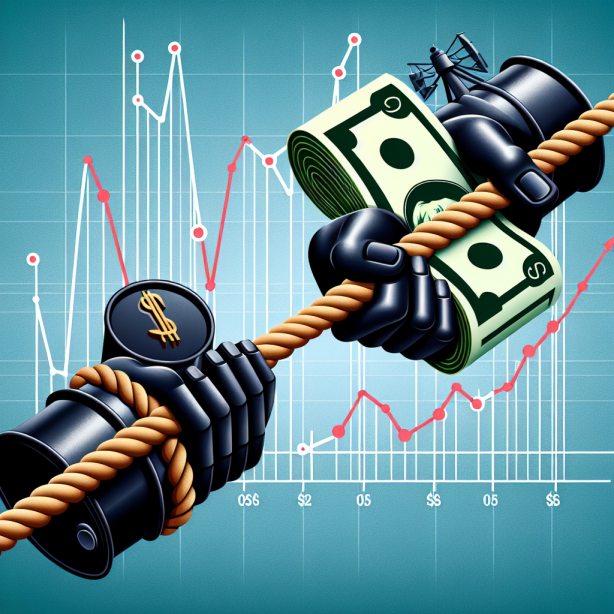
Crude Oil and Dollar Relationship: Unveiling the Power Play
May 27, 2024
Introduction
The relationship between crude oil and the U.S. dollar is one of the most scrutinized and debated topics in the financial world. Traditionally, it has been observed that when the dollar strengthens, crude oil prices tend to fall, and vice versa. However, this inverse relationship is not always consistent. Factors such as supply and demand, geopolitical issues, and market psychology play significant roles in influencing this dynamic. This essay will delve into the complexities of the crude oil and dollar relationship, explore how investors can leverage mass psychology and technical analysis, and draw wisdom from historical and modern-day experts to fortify our understanding.
The Traditional Inverse Relationship
When the Dollar Rises
When the U.S. dollar appreciates, it generally makes commodities priced in dollars, such as crude oil, more expensive for foreign buyers. This can lead to a decrease in demand, causing oil prices to fall. For example, during the late 1990s, the dollar experienced a robust appreciation due to strong economic growth in the U.S. Concurrently, crude oil prices plummeted as the more expensive dollar made oil less attractive for international buyers.
When the Dollar Falls
Conversely, when the dollar depreciates, crude oil becomes cheaper for foreign buyers, potentially increasing demand and driving up prices. An illustrative example is the period from 2002 to 2008 when the dollar weakened significantly due to economic and geopolitical uncertainties. During this time, crude oil prices surged, reaching an all-time high of $147 per barrel in July 2008.
The Relationship is Not Always Inverse
While the traditional inverse relationship holds in many cases, it is not an absolute rule. There are instances where both the dollar and crude oil prices move in the same direction. This can be attributed to supply and demand dynamics and geopolitical events.
Supply and Demand
The fundamental forces of supply and demand play a crucial role in determining crude oil prices. For instance, during the 2014-2016 oil glut, crude oil prices plummeted despite a relatively stable dollar. The oversupply in the market, driven by increased production from U.S. shale oil and OPEC’s refusal to cut output, led to a significant decline in prices.
Geopolitical Issues
Geopolitical events can also disrupt the traditional inverse relationship between the dollar and crude oil. For example, during the Iraq War in 2003, both the dollar and crude oil prices rose. The conflict raised concerns about supply disruptions from the Middle East, driving up oil prices, while the dollar strengthened due to its perceived safe-haven status.
Leveraging Mass Psychology
Mass psychology plays a pivotal role in financial markets, influencing investor behaviour and market trends. Understanding and leveraging mass psychology can provide a significant edge in the crude oil market.
One key principle of mass psychology is to buy when the market is ignored or disliked. This contrarian approach can lead to substantial gains when the market eventually turns around.
Example 1: The COVID-19 Pandemic
During the COVID-19 pandemic, crude oil prices experienced an unprecedented collapse, with WTI crude futures even briefly trading in negative territory in April 2020. Fear and uncertainty gripped the market, leading to a massive sell-off. However, astute investors who recognized the potential for a recovery and bought at the lows reaped significant rewards as prices rebounded in the following months.
Example 2: The 2014-2016 Oil Glut
The 2014-2016 oil glut saw crude oil prices fall from over $100 per barrel to below $30 per barrel. Market sentiment was overwhelmingly bearish, with many predicting a prolonged period of low prices. However, investors who took a contrarian stance and bought during this period benefited from the subsequent recovery, as prices eventually stabilized and rose.
The Great Financial Crisis
During the Great Financial Crisis of 2008-2009, crude oil prices plummeted from their peak of $147 per barrel to below $40 per barrel. The market was gripped by fear and panic, leading to widespread selling. However, investors who recognized the long-term value of crude oil and bought during this period saw substantial gains as prices recovered in the following years.
Combining Mass Psychology with Technical Analysis
While mass psychology provides valuable insights into market sentiment, combining it with technical analysis can enhance decision-making and improve investment outcomes. Technical analysis involves studying price charts and patterns to identify potential entry and exit points.
Example 1: Moving Averages and Sentiment
One effective strategy is to use moving averages in conjunction with sentiment analysis. For instance, during periods of extreme bearish sentiment, such as the COVID-19 pandemic, identifying a moving average crossover can signal a potential buying opportunity. When the short-term moving average crosses above the long-term moving average, it indicates a possible trend reversal, providing a confirmation signal for contrarian investors.
Example 2: Relative Strength Index (RSI) and Fear
The Relative Strength Index (RSI) is another valuable tool for technical analysis. During periods of extreme fear and panic, such as the Great Financial Crisis, the RSI can help identify oversold conditions. When the RSI falls below 30, it indicates that the asset is oversold and may be due for a rebound. Investors who combine this technical indicator with an understanding of mass psychology can make more informed decisions and capitalize on market reversals.
Example 3: Fibonacci Retracement and Market Ignorance
Fibonacci retracement levels can also be used to identify potential support and resistance levels in the market. During periods when the market is ignored or disliked, such as the 2014-2016 oil glut, identifying key Fibonacci retracement levels can provide potential entry points for contrarian investors. By combining these technical levels with an understanding of market sentiment, investors can improve their timing and maximize their gains.
Wisdom from Experts
Drawing on the wisdom of historical and modern-day experts can provide valuable insights and fortify our understanding of the crude oil-dollar relationship.
Charlie Munger
Charlie Munger, Warren Buffett’s long-time business partner, emphasizes the importance of understanding human behaviour and psychology in investing. He famously said, “The big money is not in the buying and selling but in the waiting.” This principle is particularly relevant in the crude oil market, where patience and contrarian thinking can lead to substantial gains.
The Rothschilds
The Rothschild banking family, known for their immense wealth and influence, has long advocated for a contrarian approach to investing. Nathan Rothschild is often quoted as saying, “The time to buy is when there’s blood in the streets.” This principle aligns with buying when the market is ignored or disliked, as it can lead to significant opportunities when the market eventually turns around.
Robber Barons
The Robber Barons of the late 19th and early 20th centuries, such as John D. Rockefeller, understood the importance of controlling supply and demand in the oil market. Rockefeller’s Standard Oil Company dominated the industry by strategically managing production and distribution. This historical example highlights the importance of considering supply and demand dynamics in the crude oil market.
Plato
The ancient Greek philosopher Plato emphasized the importance of knowledge and understanding in decision-making. He famously said, “A good decision is based on knowledge and not on numbers.” This principle is particularly relevant in the crude oil market, where understanding the broader context and underlying factors can lead to better investment decisions.
A Trip Down Memory Lane
This is what we said almost 15 years ago:
The dollar came within striking distance of our first target, 90, and it’s still possible it could hit the higher targets in the 93-96 ranges. The dollar is now due for what appears to be a sharp correction, and if this correction gathers more steam, it could result in a resumption of the dollar’s downtrend—market update Nov 25, 2008.
Today, the dollar has been observed to trade below the crucial price point of 85.50. This occurrence indicates that the corrective phase is beginning to gain momentum. It is important to note that during this phase, the dollar should not trade below 83.70-84.00 for more than six days. If it does, the next potential target could be 81. If 81 is hit, a rally should ensue, and the dollar must test at least the 83.00 range before experiencing a pullback. Failure to do so could result in the following target becoming 78.
It is worth noting that the dollar can trade down to 75, yet a new high may still be within reach. However, suppose the dollar trades below 75 for three consecutive days. In that case, it is imperative to consider the possibility that it may have peaked and is now poised to continue its downward trajectory.
Oil price and dollar correlation: Historical Look
If it trades below 63 for more than three days in a row, the next target will be a test of 54. Market update, Nov 4, 2008
Oil has now hit almost all its typical targets, and we are entering extreme target ranges. Oil traded below 54, tested 51, and it had to trade above 54 within three days of testing 51; instead, it traded below 51 and, in doing so, has now triggered the possibility of testing the 45 mark. Market update Nov 25, 2008
Crude oil prices tumbled to a low of 40.50 before finding some relief in a subsequent rally. It is unsurprising to witness such a recovery, given that the oil market is presently in a state of oversold conditions. However, the rally is expected to face significant resistance at the 48 level. If oil can sustainably trade above this range for three consecutive days, it may pave the way for a test of the 56 range. However, oil prices will likely retest their previous lows before the formation of a long-term bottom.
Conclusion
The relationship between crude oil and the U.S. dollar is complex and influenced by various factors, including supply and demand dynamics, geopolitical issues, and market psychology. While the traditional inverse relationship holds in many cases, it is not an absolute rule. By understanding and leveraging mass psychology, combining it with technical analysis, and drawing on the wisdom of historical and modern-day experts, investors can gain a more comprehensive understanding of the market and make more informed decisions.
As Charlie Munger, the Rothschilds, the Robber Barons, and Plato have taught us, a holistic approach to investing is essential for achieving long-term success. By being patient, thinking contrarian, and considering multiple factors, investors can navigate the complexities of the crude oil and dollar relationship and capitalize on potential opportunities.
Jean Baudrillard
French Postmodern Philosopher, Writer
The Art of Discovery: Articles that Open New Worlds
Inductive Versus Deductive reasoning










